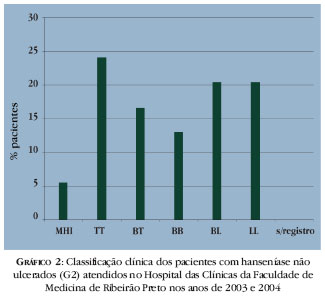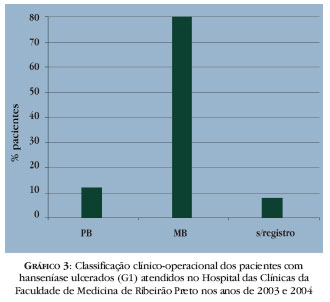FUNDAMENTOS: A hanseníase é uma doença de evolução crônica cuja lesão nervosa determina alterações sensitivas e motoras, levando à instalação de deformidades assim como as úlceras cutâneas. OBJETIVO: Traçar perfil epidemiológico dos hansenianos ulcerados e não ulcerados atendidos no Hospital das Clínicas de Ribeirão Preto 2003/2004. MÉTODOS: Estudo transversal de 79 hansenianos atendidos em 2003 e 2004 junto ao Arquivo Médico, separando-os em Grupo 1 RESULTADOS: Nesta amostra, 69,6% eram do sexo masculino, 91,1% brancos e baciloscopia positiva em 62%. Destes, 25 (32%) pacientes apresentaram ulcerações (Grupo 1) localizadas nos membros inferiores em 68% dos casos, classificados como grau II de incapacidade (72%), diferente em relação ao grupo 2 (p<0,01). Na classificação espectral da hanseníase, comparando os pares de grupos observaram-se diferenças entre tuberculóide e virchowiano (p<0,01), dimorfo e dimorfo-virchowiano (p<0,05), e este com virchowiano (p<0,01). Na operacional, 80% dos ulcerados eram multibacilares enquanto 12% paucibacilares (p<0,05). CONCLUSÕES: Os Grupos 1 e 2 foram epidemiologicamente semelhantes. As ulcerações dos hansenianos parecem estar relacionadas ao grau II de incapacidade e à positividade da baciloscopia, características detectadas por ambas as classificações (espectral e operacional).
Anormalidades; Hanseníase; Úlcera cutânea






